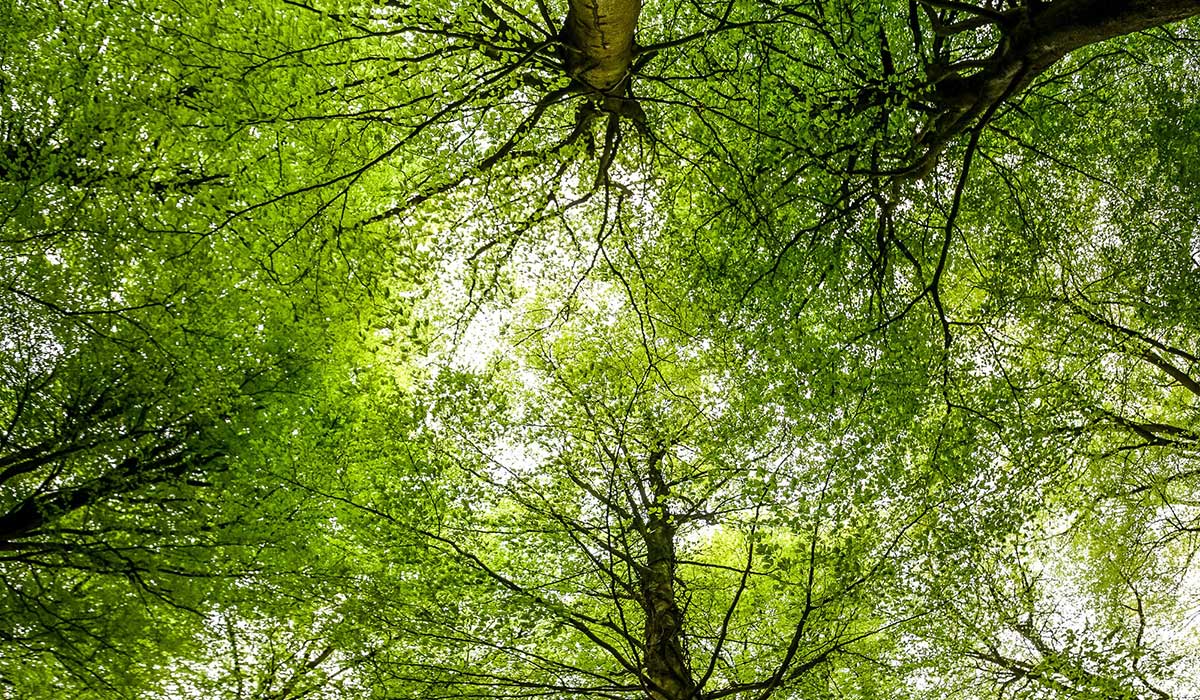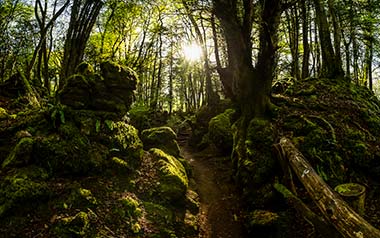
At Puzzlewood there are plenty of trees to see, but the five most common are oak, ash, yew, beech and lime.

Yew is often mistaken as a softwood but, like the others, it’s actually a hardwood and they all fulfil a role, both historically and today, providing material for a wide range of applications.
Many of our trees are hundreds of years old, so we are very mindful of taking good care of them. Martyn, our tree surgeon, works in conjunction with Steve, an expert in trees, to regularly survey and monitor the health of every tree and then carry out whatever work is needed to keep them in tip-top condition. So let’s take a closer look at these five wonderful species of tree.
Yew (Taxus Baccata)
The yew is one of our oldest species of tree and can reach ages of 400-600 years. A handful of yew trees in Britain are believed to predate the 10th century. Yews can grow up to 20m in height and have a distinctive dark reddish bark. Old trees will continue to stand even if their trunks are virtually hollow.
It’s quite well known that yews are often a common feature in churchyards, partly because the yew was a symbol of immortality but also because it was a practical measure to keep grazing cattle away – yew leaves are highly toxic. Probably less well known is the fact they are often found growing in areas where there is evidence of open cast iron mining. It is believed that yews would be planted to help in the process – the root systems would help open up the seams of ore. With Puzzlewood’s history of mining, it’s little wonder that there are so many ancient yew trees here.
Oak (Quercus Robur)
The English oak is a deciduous tree that can grow up to 20-40m in height. Its typical lifespan is around 200 years, but there are some examples that are believed to be at least 1000 years old. Acorns, the fruit of the oak, aren’t produces until a tree is approximately 40 years old. The oak’s canopy is fairly open and widespread, which allows light to reach the ground below and allows plant and animal life to flourish – hence the wonderfully archetypical image of bluebells and primroses carpeting the woodland floor. Insect life is well supported by the oak, including woodlice, centipedes and caterpillars. They, in turn, are a food source for small animals, bats and birds such as the marsh tit and the pied flycatcher. And of course, acorns provide food for animals such as squirrels.
Ash (Fraxinus Excelsior)
The ash tree is one of the most common trees in Britain and can live up to 400 years. It can grow up to 35m and 15m wide, with a strong and wide root system. Like the oak, ash trees have airy canopies so support life on the woodland floor – the fact that they shed their leaves early also helps. Around the base of an ash, you might find wildflowers such as dog violet, wild garlic and dog mercury – we certainly have plenty of wild garlic at Puzzlewood. Up above, many birds will nest in the branches of ash trees – including bullfinches, woodpeckers, owls, redstarts and nuthatches. Insect life also thrives on the ash – including the endangered high brown fritillary, caterpillars of several moths and stag beetles that all make their homes in the dead wood. The ash produces winged fruit, known as keys, that fall in winter and early spring.
Lime (Tilia x Europaea)
The common lime is native to Britain. It can grow up to 40m tall and typically lives for about 500 years. It’s a shady tree, a quality that has made it popular in urban environments. Unfortunately, the sticky secretion produced by the lime is less welcome in that same environment – not something that bothers us at Puzzlewood. Lime trees are the perfect habitat for many species of moth during the caterpillar stage. Lime also attracts hoverflies, ladybirds and even bees. Older limes and dead wood are home to wood-boring beetles and nesting birds.

Beech (Fagus Sylvatica)
The beech tree arrived in England during the Bronze Age. A mature beech can reach a height of 40m and can live for hundreds of years. The shade created by its dense canopy – and a deep carpet of fallen leaves – prevents the growth of most woodland plants. However, some shade-loving wildflowers will persevere, including coralroot bittercress and various orchids. The tree’s foliage provides food for the caterpillars of moths such as the clay triple-line and the olive crescent. Meanwhile, the fruit of the beech, known as beechmast, is eaten by squirrels, birds, mice and voles. The beech has a symbiotic relationship with native truffle fungi. The fungi help the host tree obtain nutrients in exchange for sugar produced through photosynthesis.







